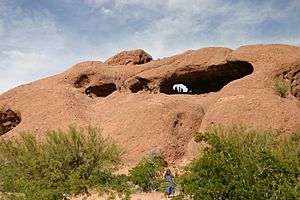Papago Park facts for kids
Quick facts for kids Papago Park |
|
|---|---|
 |
|
| Location | Phoenix and Tempe, Arizona |
| Nearest city | Scottsdale, Arizona |
| Area | 1,496 acres (6.05 km2) |
| Operated by | Cities of Phoenix and Tempe, Arizona |
Papago Park is a big park located in the cities of Phoenix and Tempe, Arizona, in the United States. It's known as a special "Phoenix Point of Pride."
This park is home to Hunt's Tomb, which is a historic site.
Contents
About Papago Park
Papago Park is a desert park with hills. It covers about 1200 acres in Phoenix and 296 acres in Tempe. The part in Tempe is sometimes called Tempe Papago Park.
The park is famous for its unique rock shapes and many desert plants. You can see giant saguaro cacti here. Papago Park also has the Desert Botanical Garden, a large zoo called the Phoenix Zoo, and places for picnics. There are small lakes, hiking trails, and paths for bikes. You can also find a fire museum and Hunt's Tomb, which is a pyramid-shaped tomb for Arizona's first governor, George W. P. Hunt.
In Tempe Papago Park, you'll find fields for baseball and softball. There are also picnic shelters and a small lake. The Rolling Hills Golf Course is also part of the park. The park even has the home stadium for baseball and softball teams from North Pointe Preparatory.
History of Papago Park

The cool red sandstone rocks in Papago Park were formed millions of years ago. One famous rock is called Hole-in-the-Rock. It has openings that were naturally carved out over time. Some people believe that the Hohokam tribe, who lived in this area long ago, used these openings to track the solstices (the longest and shortest days of the year).
You can also find signs of very old granite rocks in the park. The main rock layer is covered by only a thin layer of dirt.
In 1879, Papago Park was set aside for the local Maricopa and Pima tribes. Later, in 1914, it became the Papago-Saguaro National Monument. But in 1930, the government decided it wasn't suitable for a national monument. So, the park was divided among the state of Arizona, the city of Tempe, and a group called the Water Users Association (now the Salt River Project).
During the Great Depression, in 1932, Governor Hunt started a fish hatchery in Papago Park. This hatchery was built as a Works Progress Administration (WPA) project, which helped people find jobs. It raised largemouth bass and other fish for Arizona's rivers and lakes.
During World War II, Papago Park was used as a POW camp (Prisoner of War camp). From 1942 to 1944, it held up to 3,100 prisoners. The camp was also the site of the biggest mass escape from any US prison camp during World War II. This event, called the Great Papago Escape, happened on December 23, 1944. Twenty-five prisoners, including a German U-boat commander named Jürgen Wattenberg, escaped through a 178-foot tunnel. Many prisoners soon realized they didn't know the desert and gave up. Wattenberg was the last one caught, on January 28, 1945.
After the war, the POW camp site became a hospital for veterans from 1947 to 1951. Then, it was used by the Army Reserve.
The part of Papago Park owned by the state was sold to the city of Phoenix in 1959. The fish hatchery also closed that year because it was no longer needed.
In 1962, the City of Phoenix rented the hatchery grounds, including its man-made lakes, to the Arizona Zoological Society. This is how the Phoenix Zoo started! A small stone house that was used by the hatchery caretaker is still part of the zoo today.
A section of the park in Tempe was given to that city in 1935. An 18-hole golf course was built by the city of Phoenix and finished in 1963. Papago Park was also the finish line for the fourth season of the TV show The Amazing Race.
Hunt's Tomb
Hunt's Tomb is a small white pyramid located on top of a hill in Papago Park. It's behind a fence. George W.P. Hunt, who was Arizona's first governor, had this tomb built in 1931 for his wife. When he passed away in 1934, he was also buried there. Their daughter and other family members are buried there too.
Papago Ponds
The Papago Ponds are small lakes with a surface area of about 6 acres (2.4 ha). They are usually about 8 ft (2.4 m) deep. The elevation of this area is about 1,100 ft (340 m).
Fish Species in the Ponds
Other Animals Living Near Papago Ponds
Images for kids
-
Sandra Day O'Connor's House, which was moved from the town of Paradise Valley, Arizona to Papago Park.








